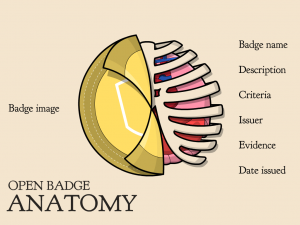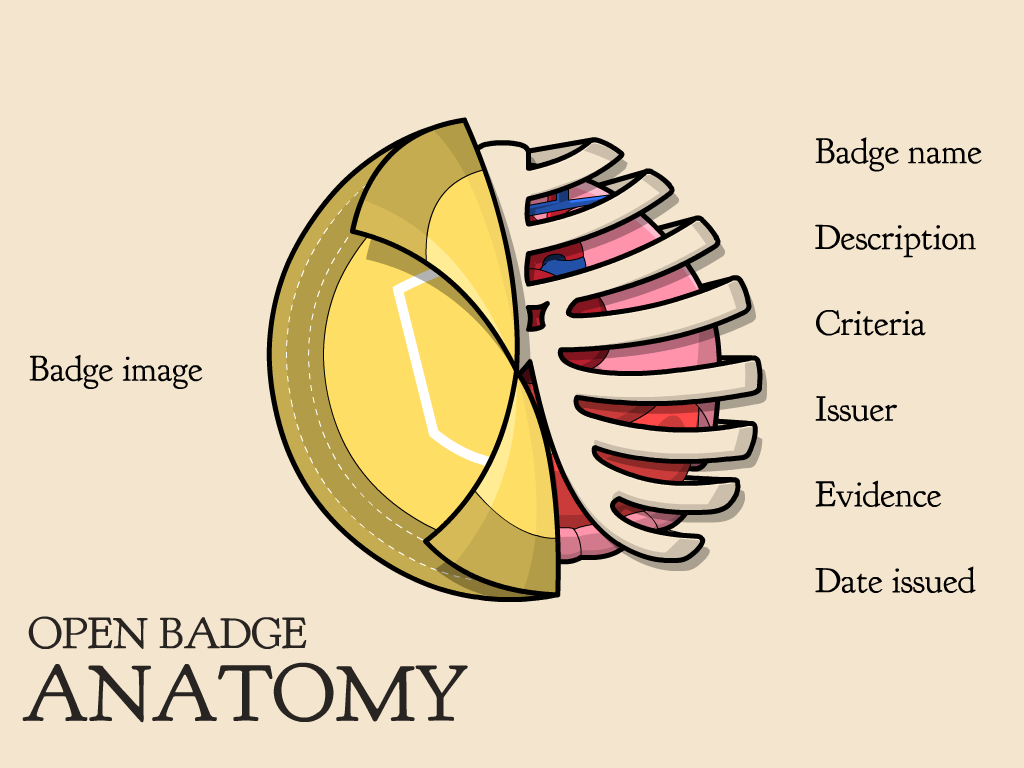If you have ever been a boy scout or girl guide, you would have been awarded a badge to recognise your achievements in a skill, experience or deed. This would have been sewn proudly on your shirt or blouse for all to see. In formal education, you are awarded certificates that demonstrates your academic or vocational ability or achievements. These certificates are usually hung proudly on your office wall that tells someone that you are a recognised and qualified dentist or plumber. We also do a lot of informal education that isn’t recognised or accredited because it is usually something that we have to do or want to do. These informal activities tend to contribute to our ever-growing knowledgebase, experiences and skill sets, but are not formally acknowledged or recognised.
I have recently come across an initiative called “Open Badges” by the Mozilla Foundation. Essentially, “open badges” are “images with metadata hard-coded into them“. The metadata contains information around the acquisition of the badge such as the name and description of the badge (or achievement), details of the issuer (such as issue date, name of the issuer, the issuing organisation), and details of the recipient (so that the badge, or achievement, is properly attributed and awarded). For a good introduction to “open badges”, check out Dr. Doug Belshaw‘s slidedeck on SlideShare. Doug Belshaw, who is the Badges and Skills Lead at the Mozilla Foundation, offers a range of properties associated with the open badges (Belshaw, 2013):
- visual representations of achievements, learning, skills, interests, and competencies;
- can complement traditional educational practices (such as accreditation and certification)
- can accommodate formal & informal learning pathways
- can represent hard & soft skills, peer assessment, and stackable lifelong learning;
- can capture learning wherever & however it ccurs;
- “assessment by stealth”.

I can see the providers of the Massive Open Online Courses (MOOCs) like Coursera, edX, Udacity (from the USA) and OCTEL and OLDSMOOC (from the UK) making use of this initiative. Indeed, the OLDSMOOC provider is already awarding 9 open badges in total, based upon the Mozilla model. Similarly, JISC RSC Scotland have developed a series of courses around being a Digital Practitioner and Digital Innovator that will also be making use of open badges scheme (Hamilton, 2013).
So what of degrees and diplomas? What of Higher Education? In the US, reports seem to suggest some advocacy towards the idea (Young, 2012; Udas, 2012). However, there are concerns over legitimacy, ‘style over substance’, governance, the commodification of learning, authentication, etc. In the UK, we have just introduced the Higher Education Achievement Report (HEAR) which:
provides a single comprehensive record of a learner’s achievement … enables institutions to provide a detailed picture of student achievement throughout a students’ time at university, including academic work, extra-curricular activities, prizes and employability awards, voluntary work and offices held in student union clubs and societies that have been verified by the institution.
There is certainly some real currency in linking the HEAR scheme with the Open Badge project. However, in a brief blog article, Seb Schmoller compares the similar reactions by the Higher Education sector to MOOCs and the proposal to moving scholarly publishing to the Open Access Model (Schmoller, 2013) which were quite hostile. I see a similar fate befall the open badge project, which is a shame as I see some real value here in terms of lifelong and life-wide learning linked with personal e-portfolios. The challenge is to get government, industry and the Academy see the value in this as well.
References
Belshaw, D.A.J. (2011). “Badges for Lifelong Learning: Reframing the Debate”. DMLcentral, 26.9.2011. Available at: http://dmlcentral.net/blog/doug-belshaw/badges-lifelong-learning-reframing-debate [Accessed 9.2.2013].
Belshaw, D.A.J. (2013). “Open Badges: what’s all this, then?”. Bristol e-learning meetup, 16.01.2013. Available at: http://www.slideshare.net/dajbelshaw/open-badges-whats-all-this-then [Accessed 9.2.2013].
Burgess, R. (2012). Bringing it all together: Introducing the HEAR – The final report of the Burgess Implementation Steering Group. London: Universities UK. Available at: http://www.hear.ac.uk/assets/documents/hear/institution-resources/HEAR-Bringing-it-all-together.pdf [Accessed 9.2.2013].
Casilli, C. (2012). “Mozilla Open Badges: building trust networks, creating value”. Persona Blog, 24.8.2012. Available at: http://carlacasilli.wordpress.com/2012/08/24/mozilla-open-badges-building-trust-networks-creating-value/ [Accessed 9.2.2013].
Hamilton, G. (2013). “Developing the series, information and designs for the JISC RSC Scotland #openbadges”. JISC RSC Scotland eAssessment, 15.01.2013. Available at: http://www.rsc-scotland.org/eassessment/2013/01/15/developing-the-series-information-and-designs-for-the-jisc-rsc-scotland-openbadges/ [Accessed 9.2.2013].
Schmoller, S. (2013). “MOOCs and Open Access: parallel reactions”. Fortnightly Mailing Blog, 9.2.2013. Available at: http://fm.schmoller.net/2013/02/moocs-and-open-access-parallel-reactions.html [Accessed 9.2.2013].
Udas, K. (2012). “Is There Merit in a ‘Badge’ System That Certifies Higher Education Achievement?”. UMassOnline Blog, 17.1.2012. Available at: http://www.umassonlineblog.com/2012/01/17/is-there-merit-in-a-badge-system-that-certifies-higher-education-achievement/ [Accessed 9.2.2013].
Young, J.R. (2012). “‘Badges’ Earned Online Pose Challenge to Traditional College Diplomas”. The Chronicle, 8.1.2012. Available at: http://chronicle.com/article/Badges-Earned-Online-Pose/130241/ [Accessed 9.2.2013].

Thanks for this post. I agree that Open Badges could link well with the HEAR scheme.
In terms of formal education, I think there are a number of areas where the Open Badge Infrastructure could provide a framework for assessment that aligns with a ‘primary through to tertiary education’ assessment agenda. In Scotland, I think the Open Badges concept fits closely with the capacities of the Curriculum for Excellence (spans Scottish curriculum for 3-18 year olds) (http://www.educationscotland.gov.uk/thecurriculum/whatiscurriculumforexcellence/index.asp) and also with the idea of graduate attributes in higher education. This was commented on at the 2012 QAA conference and I believe they could provide a bridge when it comes to articulation between further and higher education. The ICT in Education Excellence Group, (convened by the Scottish Government’s Chief Scientific Adviser), in their final report for the re-development of the Scottish schools’ intranet, GLOW, include a number of User Stories (Appendix F) focusing on the use of Open Badges for a variety of purposes including to motivate engagement and reward contribution (http://www.scotland.gov.uk/Resource/0041/00412968.pdf).
So I think there is interest, in Scotland at least, and I hope we’ll find out more at the Open Badges Design Day I’m facilitating in a couple of weeks time.
As an aside, I’m a member of the project team on the ocTEL MOOC and have been pushing the use of Open Badges. Time is the issue but I would love to see them being used!